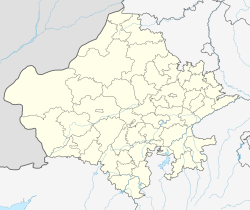| Bijolia Parshvanath temple | |
|---|---|
 Shri Digambar Jain Parshwanath Atishay Kshetra | |
| Religion | |
| Affiliation | Jainism |
| Sect | Digambara |
| Deity | Parshvanatha |
| Festivals | Mahavir Jayanti |
| Governing body | Shri Digambar Jain Parshwanath Atishay Kshetra Committee |
| Location | |
| Location | Bijolia, Rajasthan |
| Geographic coordinates | 25°08′59.3″N75°20′15″E / 25.149806°N 75.33750°E |
| Architecture | |
| Creator | Mahajan Lala |
| Date established | 12th century |
| Temple | 11 |
Bijolia Parshvanath Temple or Tapodaya Teerth Kshetra is a Jain pilgrimage center located in Bijolia town in Bhilwara district of Rajasthan.













